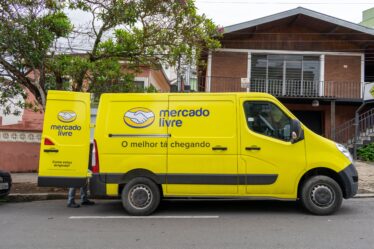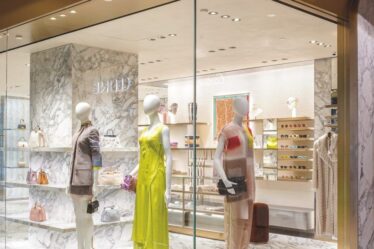
Los Angeles-based designer Doni Nahmias had a big launch planned in November for his first sneaker, which he designed as an ode to two classic shoes, the Converse Chuck Taylor and Nike Air Max. It was going to be a major step for Nahmias’ namesake California street-and-skate meets luxury menswear brand, founded in 2018.
Due to factory delays, the products did not ship until early January.
“As a small brand we got pushed to the side,” said Nahmias. “It wasn’t the launch I was hoping for.”
Independent brands have gotten used to things not going as planned over the past three years. Since the onset of the pandemic, there’s been an unending series of challenges: first store closures and the e-commerce boom during the lockdowns, then supply chain snafus and inflation as the world reopened.
Plenty of new brands survived – and even thrived – amid the chaos. But there’s more turbulence ahead: retailers concerned about lingering inflation and an economic downturn are reluctant to bet on untested brands. Meanwhile, investors are turning towards so-called recession-proof companies, a category that rarely includes emerging fashion labels.
“It’s almost like a rule. When recession hits, stop investing in fashion because it’s [seen as] too unpredictable,” said Gary Wassner, chief executive of luxury and fashion advisory Hilldun Corporation.
After surviving the pandemic, young brands are generally more disciplined when it comes to maintaining margins and inventory. Many designers and founders are now self-taught supply chain experts. To make it through a recession, they will have to deploy the tactics they honed during the pandemic and further focus on cutting risk and driving sales.
Unlike in 2020, at least they’ll be able to plan ahead.
“In the past it was kind of a reaction to what was going on, this is something we can really strategise more,” said Willy Chavarria, founder and creative director of his namesake brand. “There’s a lot less room for frivolity in our line of work [now].”
Betting on Winners
Fashion brands always seek to strike a balance between creativity and commerciality. During a downturn, they will have to lean more on the latter.
Retailers burned by ordering too much inventory last year are expected to make smaller buys and focus on brands and products with historically strong sell-through rates in 2023.
“For a while the stores needed those hyped brands,” said Wassner. “Now they need brands everybody buys.”
Julie Gilhart, chief development officer of brand incubator Tomorrow Ltd. and president of Tomorrow Consulting, said many brands will present more tightly-edited collections this year.
For Judy Turner’s upcoming collection, set to be shown in February, founder and creative director Conley Averett tinkered with old ideas that didn’t quite hit to make them more commercially viable.
“I’m trying to make sure the vision is more tailored and clear to those who are having trouble understanding it,” said Averett.
Nahmias, meanwhile, is meeting with buyers earlier and paying more attention to reliably popular products like jerseys, T-shirts and hats.
With future wholesale orders less of a sure thing, labels are steering shoppers to their own sites. Chavarria will offer made-to-order products exclusively on the brand’s website immediately following its February show. He’ll also do more off-calendar drops and collaborations to generate sales and keep the label top-of-mind throughout the year.
Like retailers, the last thing a brand wants is to get caught with excess inventory. Emma Gage, founder and designer of the gender-neutral apparel brand Melke, thinks that puts labels working in smaller runs at an advantage. Gage founded Melke during the pandemic, so she focused on building relationships with local, New York-based suppliers, which she said has given her more flexibility on orders.
“I have product that I’ll be able to sell and bring with me. I’m not over-producing,” said Gage.
Pandemic disruptions left more room for brands to chart their own paths. Brands shored up direct-to-consumer channels, so they aren’t as reliant on being in specific stores.
Back to Creativity and Community
The limitations of tough periods can bog down designers.
“There’s times when you need to focus on your business and there’s times when you get to be more creative,” said Dauphinette founder Olivia Cheng. “But when business maybe isn’t going as well, it really stifles your creativity because you don’t feel like you have the resources mentally or financially to really design.”
To combat downturn blues, brands are seeking innovative ways to get products to consumers. Cheng plans to host a Lunar New Year party in January, where she’ll drop specially-developed shirts and launch a new vintage and upcycled concept.
Melke, Judy Turner and Dauphinette, among other labels, are staging pop-ups, opening studios for visits, or hosting trunk shows and archive sales to move merchandise at a low cost and get face time with shoppers.
Brands are also reevaluating how they show their collections, an easier task post-pandemic, as buyers and editors have become increasingly open to viewing collections virtually or off-schedule.
Nahmias, for one, said he will keep showing during fashion month, but will likely cut the cost of his Paris-staged show by half. Cheng will show following fashion month after her presentation in New York last September, which her personal savings partially financed, didn’t get the reaction she hoped for.
“It’s a very congested calendar, I just want to give myself the opportunity to try something different,” said Cheng.
Leaning into the strengths that come with being small and independent — agility, ingenuity, point-of-view and a passionate, plugged-in customer base — is what will help brands weather the storm.
Willy Chavarria, for example, gained buzz in part for spotlighting the intricacies of Latinx culture, queerness and gender in shows. His Spring/Summer 2023 presentation “Please Rise” began with a hymn about crossing borders, and his Autumn/Winter 2022 “Uncut” collection focused on American stereotyping of Latinx people.
“The brand is much more than just apparel, we’re selling something that’s very personal,” said Chavarria.
Chavarria wants to further emphasise that connection, adding new content to its site and highlighting other artists Chavarria sees as aligned with the brand ethos. Drops will be accompanied by special imagery and videos to encourage consumers to linger on the brand’s website.
“These brands that have something to say and know how to create community are the ones that are going to be the most successful,” said Gilhart. “This is not the onslaught of gloom and doom. It’s like a cold, as opposed to a full on flu.”



